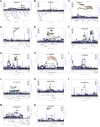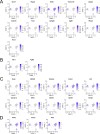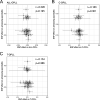Genetic insights into ossification of the posterior longitudinal ligament of the spine
- PMID: 37461309
- PMCID: PMC10353864
- DOI: 10.7554/eLife.86514
Genetic insights into ossification of the posterior longitudinal ligament of the spine
Abstract
Ossification of the posterior longitudinal ligament of the spine (OPLL) is an intractable disease leading to severe neurological deficits. Its etiology and pathogenesis are primarily unknown. The relationship between OPLL and comorbidities, especially type 2 diabetes (T2D) and high body mass index (BMI), has been the focus of attention; however, no trait has been proven to have a causal relationship. We conducted a meta-analysis of genome-wide association studies (GWASs) using 22,016 Japanese individuals and identified 14 significant loci, 8 of which were previously unreported. We then conducted a gene-based association analysis and a transcriptome-wide Mendelian randomization approach and identified three candidate genes for each. Partitioning heritability enrichment analyses observed significant enrichment of the polygenic signals in the active enhancers of the connective/bone cell group, especially H3K27ac in chondrogenic differentiation cells, as well as the immune/hematopoietic cell group. Single-cell RNA sequencing of Achilles tendon cells from a mouse Achilles tendon ossification model confirmed the expression of genes in GWAS and post-GWAS analyses in mesenchymal and immune cells. Genetic correlations with 96 complex traits showed positive correlations with T2D and BMI and a negative correlation with cerebral aneurysm. Mendelian randomization analysis demonstrated a significant causal effect of increased BMI and high bone mineral density on OPLL. We evaluated the clinical images in detail and classified OPLL into cervical, thoracic, and the other types. GWAS subanalyses identified subtype-specific signals. A polygenic risk score for BMI demonstrated that the effect of BMI was particularly strong in thoracic OPLL. Our study provides genetic insight into the etiology and pathogenesis of OPLL and is expected to serve as a basis for future treatment development.
Keywords: Mendelian randomization; bone mineral density; genetics; genome-wide association study; genomics; human; obesity; ossification of the posterior longitudinal ligament of the spine; polygenic risk score.
© 2023, Koike, Takahata, Nakajima et al.
Conflict of interest statement
YK, MT, MN, NO, HS, XL, TE, SI, KK, TK, SK, MK, HS, TT, TM, HI, TY, MK, HN, KA, YT, KT, SI, KT, KH, YI, YK, SM, HN, KM, AS, SF, TK, KW, TT, KK, SK, MT, KY, HT, HL, SN, KO, YM, AO, MM, NI, CT, SI No competing interests declared, YK Consulting fees from Medacta International, MY representatives of Japanese Organization of the Study for Ossification of Spinal Ligament
Figures






































Update of
References
-
- Akiyama M, Okada Y, Kanai M, Takahashi A, Momozawa Y, Ikeda M, Iwata N, Ikegawa S, Hirata M, Matsuda K, Iwasaki M, Yamaji T, Sawada N, Hachiya T, Tanno K, Shimizu A, Hozawa A, Minegishi N, Tsugane S, Yamamoto M, Kubo M, Kamatani Y. Genome-wide Association study identifies 112 new Loci for body mass index in the Japanese population. Nature Genetics. 2017;49:1458–1467. doi: 10.1038/ng.3951. - DOI - PubMed
-
- Akiyama M, Ishigaki K, Sakaue S, Momozawa Y, Horikoshi M, Hirata M, Matsuda K, Ikegawa S, Takahashi A, Kanai M, Suzuki S, Matsui D, Naito M, Yamaji T, Iwasaki M, Sawada N, Tanno K, Sasaki M, Hozawa A, Minegishi N, Wakai K, Tsugane S, Shimizu A, Yamamoto M, Okada Y, Murakami Y, Kubo M, Kamatani Y. Characterizing rare and low-frequency height-associated variants in the Japanese population. Nature Communications. 2019;10:4393. doi: 10.1038/s41467-019-12276-5. - DOI - PMC - PubMed
-
- Akune T, Ogata N, Seichi A, Ohnishi I, Nakamura K, Kawaguchi H. Insulin Secretory response is positively associated with the extent of ossification of the posterior longitudinal ligament of the spine. The Journal of Bone and Joint Surgery. American Volume. 2001;83:1537–1544. doi: 10.2106/00004623-200110000-00013. - DOI - PubMed
-
- Bakker MK, van der Spek RAA, van Rheenen W, Morel S, Bourcier R, Hostettler IC, Alg VS, van Eijk KR, Koido M, Akiyama M, Terao C, Matsuda K, Walters RG, Lin K, Li L, Millwood IY, Chen Z, Rouleau GA, Zhou S, Rannikmäe K, Sudlow CLM, Houlden H, van den Berg LH, Dina C, Naggara O, Gentric J-C, Shotar E, Eugène F, Desal H, Winsvold BS, Børte S, Johnsen MB, Brumpton BM, Sandvei MS, Willer CJ, Hveem K, Zwart J-A, Verschuren WMM, Friedrich CM, Hirsch S, Schilling S, Dauvillier J, Martin O, Jones GT, Bown MJ, Ko NU, Kim H, Coleman JRI, Breen G, Zaroff JG, Klijn CJM, Malik R, Dichgans M, Sargurupremraj M, Tatlisumak T, Amouyel P, Debette S, Rinkel GJE, Worrall BB, Pera J, Slowik A, Gaál-Paavola EI, Niemelä M, Jääskeläinen JE, von Und Zu Fraunberg M, Lindgren A, Broderick JP, Werring DJ, Woo D, Redon R, Bijlenga P, Kamatani Y, Veldink JH, Ruigrok YM, HUNT All-In Stroke. China Kadoorie Biobank Collaborative Group. BioBank Japan Project Consortium. ICAN Study Group. CADISP Group. Genetics and Observational Subarachnoid Haemorrhage Study investigators. International Stroke Genetics Consortium Genome-wide Association study of intracranial aneurysms identifies 17 risk Loci and genetic overlap with clinical risk factors. Nature Genetics. 2020;52:1303–1313. doi: 10.1038/s41588-020-00725-7. - DOI - PMC - PubMed
Publication types
MeSH terms
Supplementary concepts
Associated data
- Actions
- Actions
- Actions
- Actions
LinkOut - more resources
Full Text Sources
Medical

